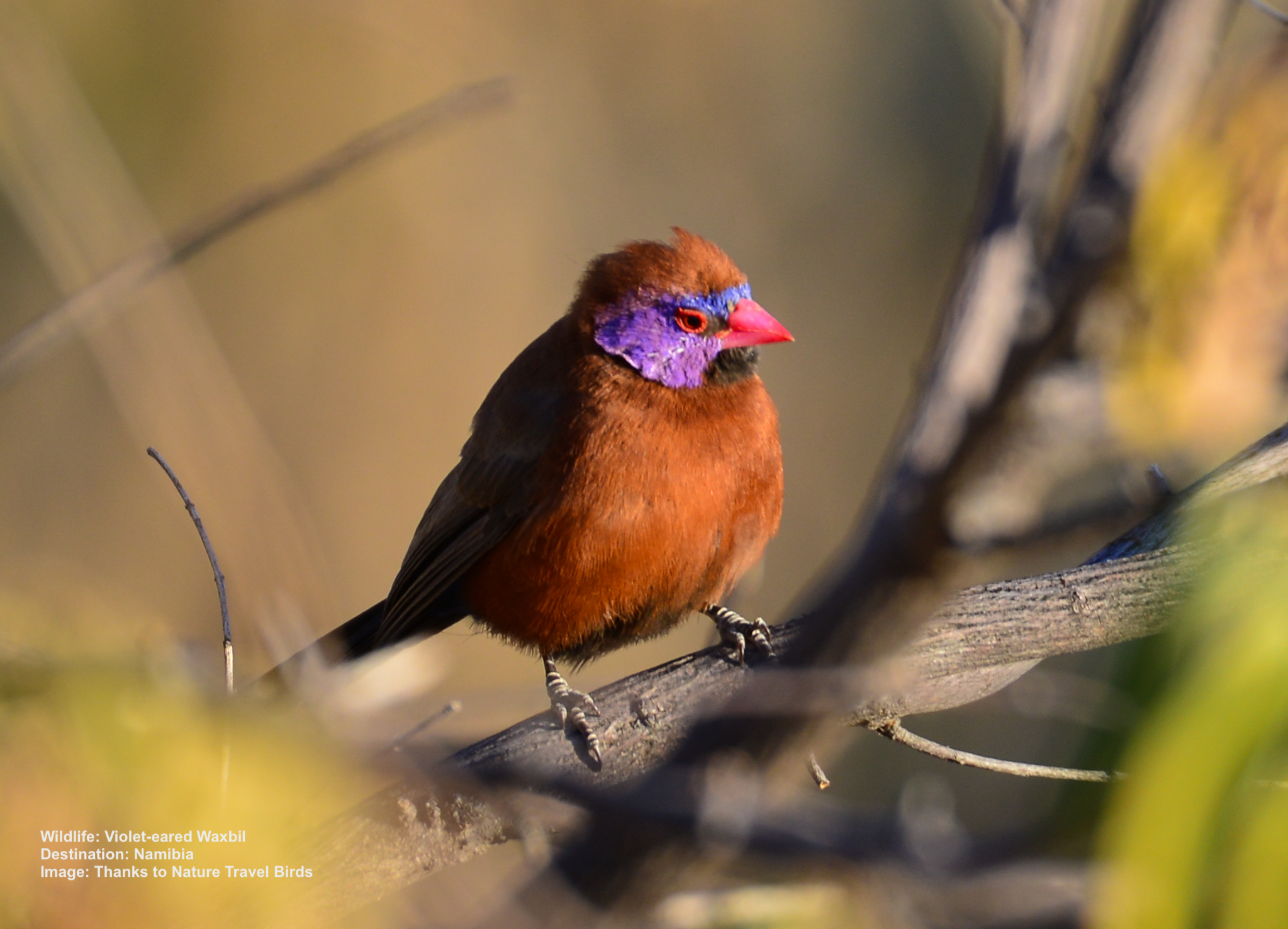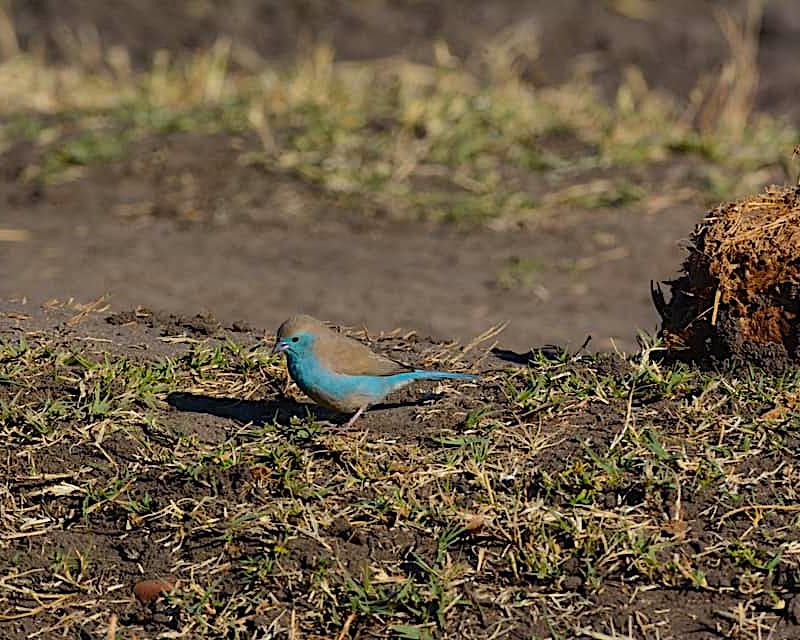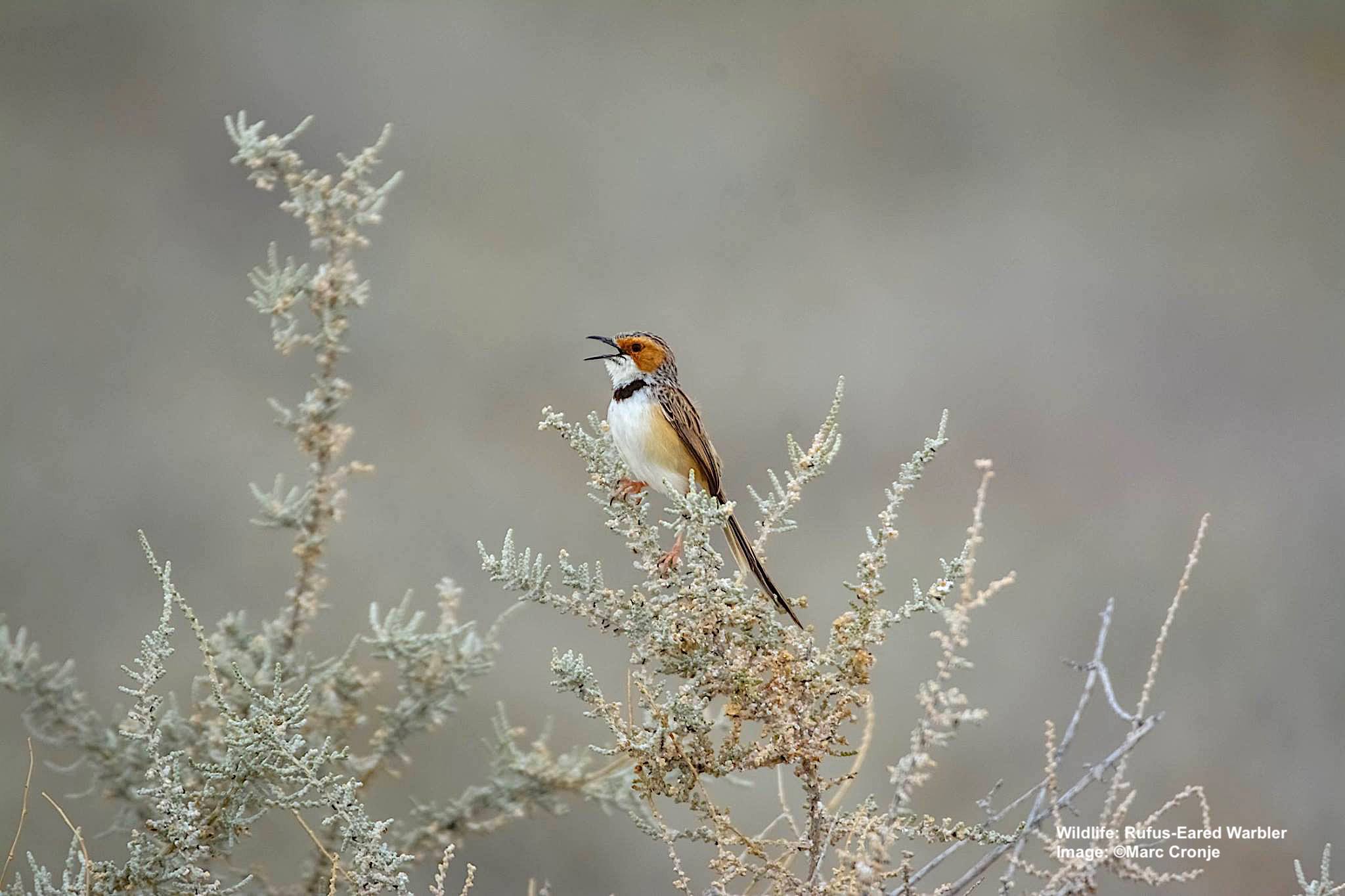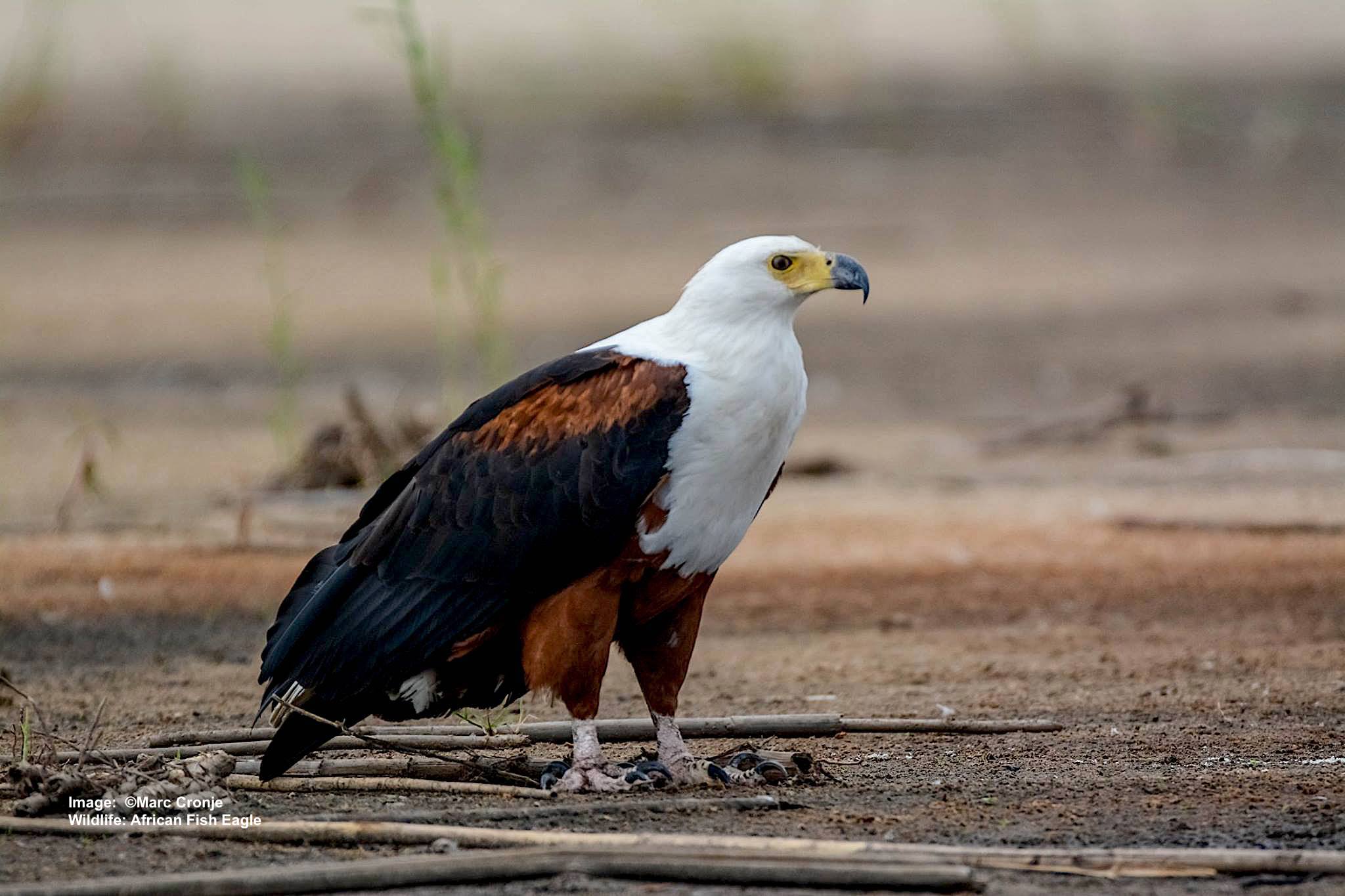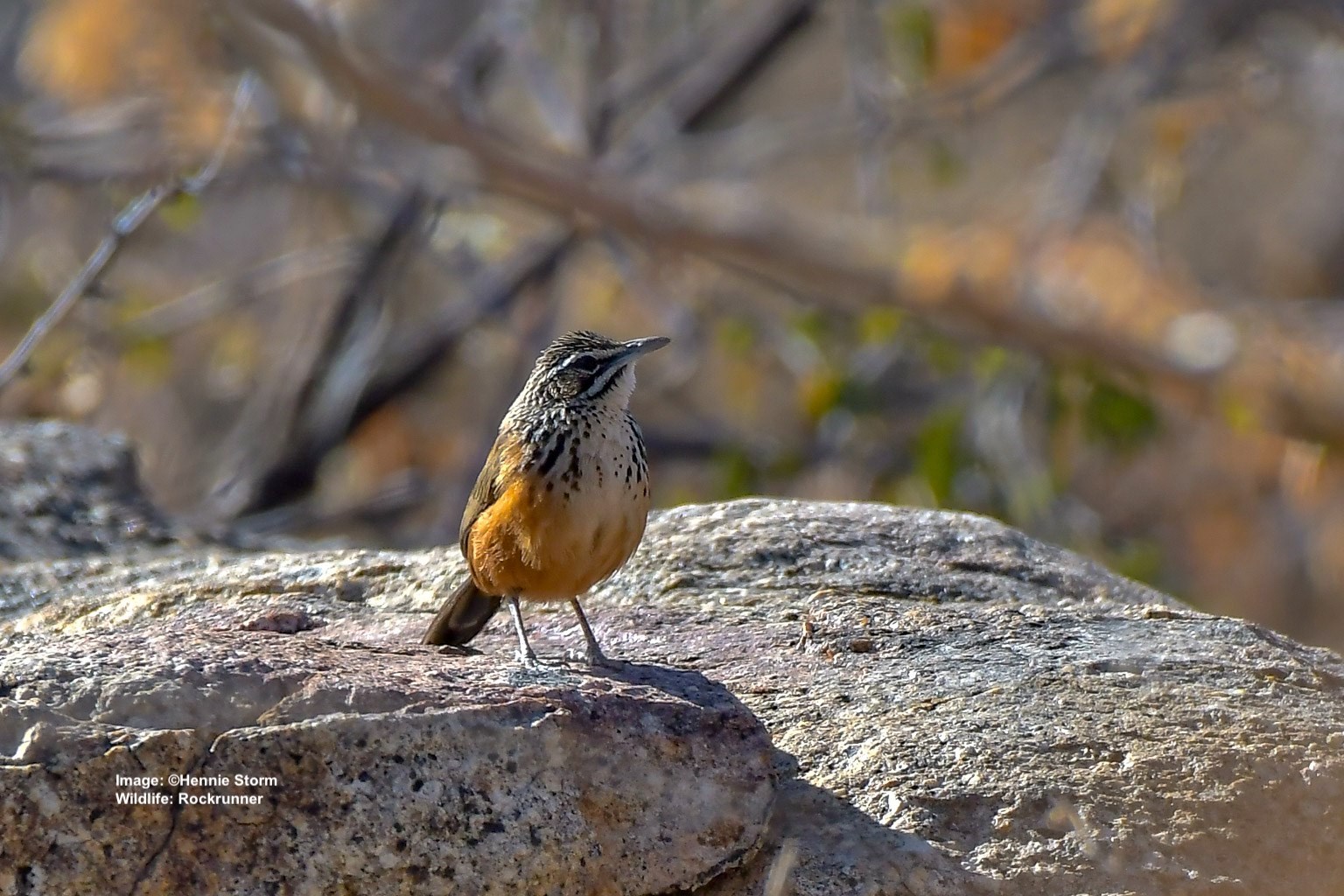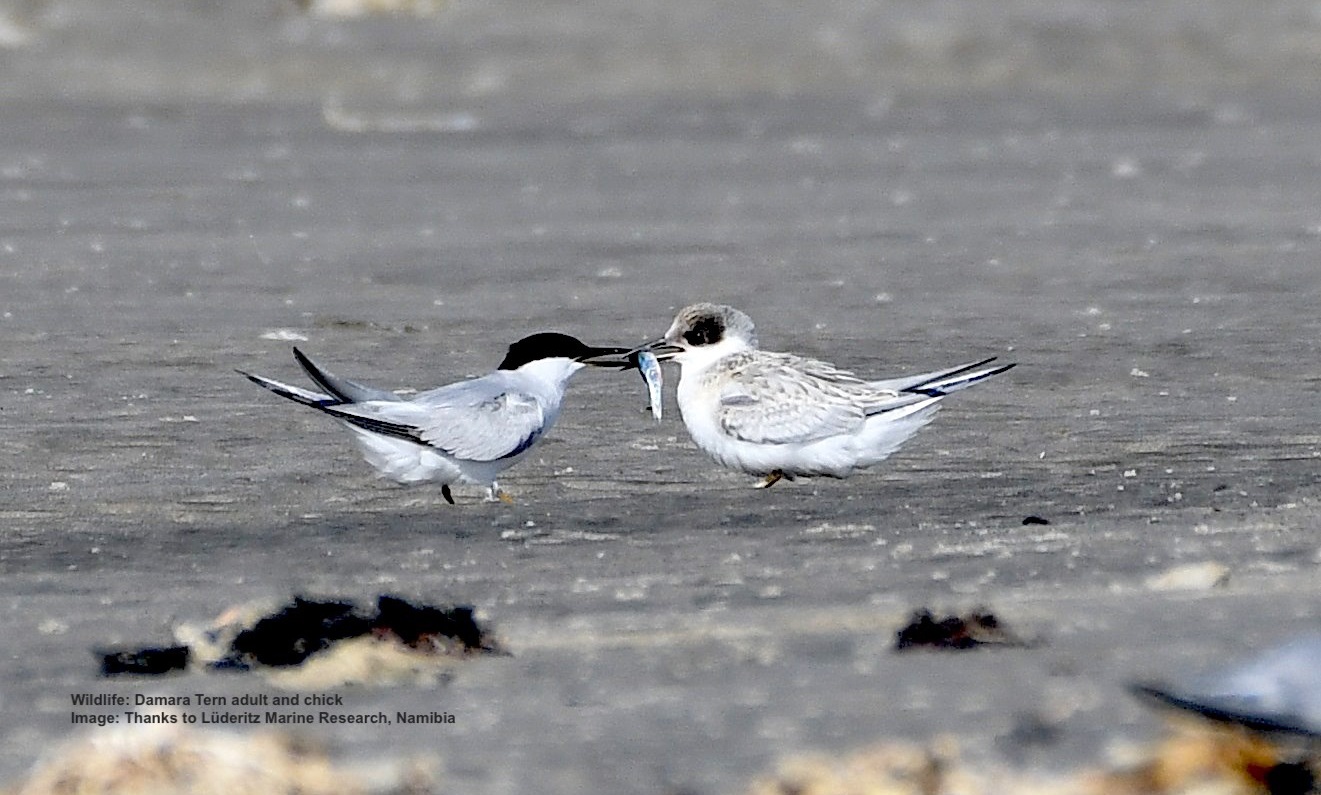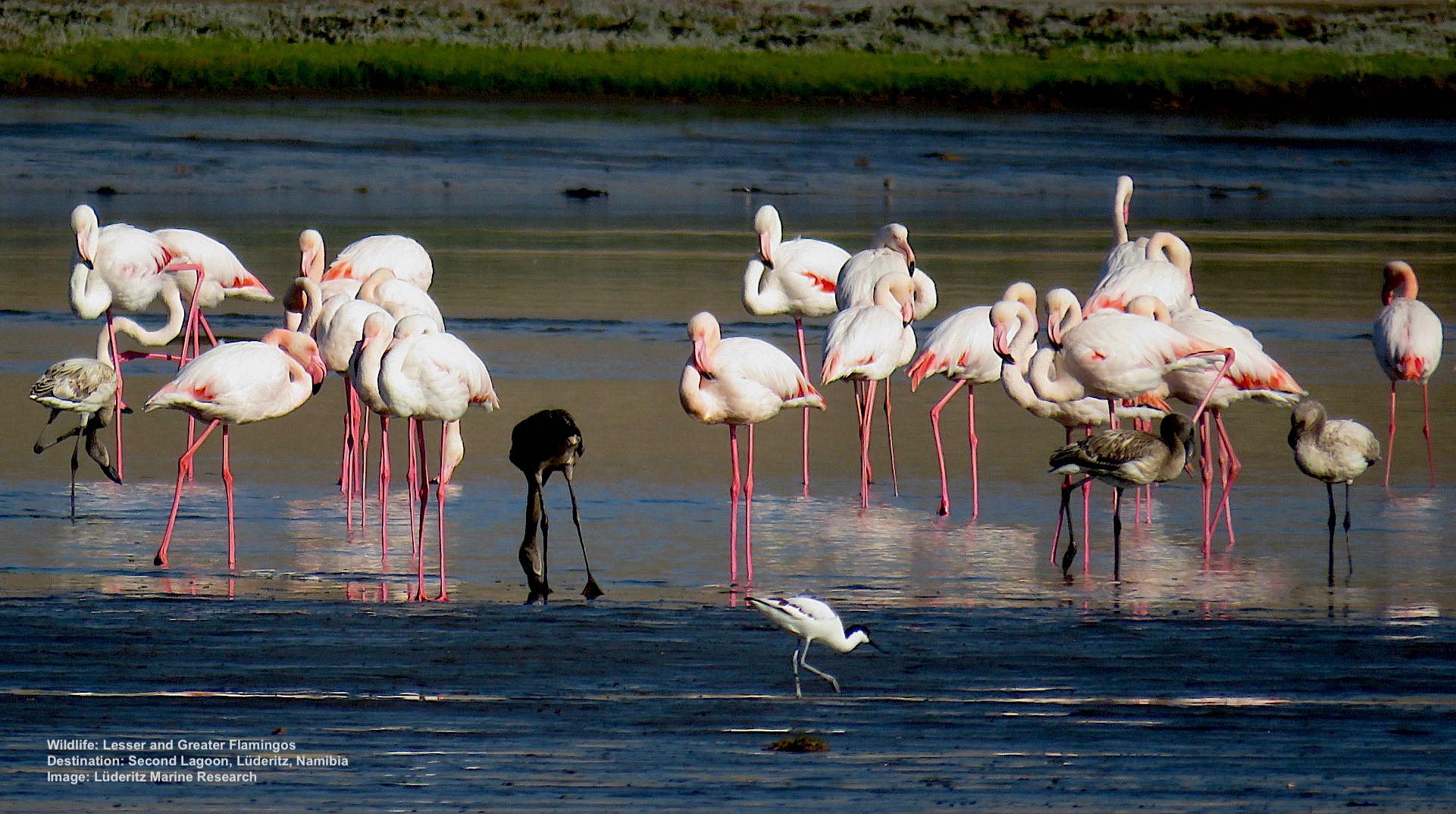10 Rare Birds Worth the Search in Surprising Namibia
ROSY-FACED LOVEBIRDS, ENDEMIC TO A SMALL SECTION OF NAMIBIA, ARE AS BEAUTIFUL AS THEIR NAME, BUT LIKE LOVERS EVERYWHERE, THEY HAVE THEIR SHARE OF RELATIONSHIP DRAMA. IMAGE: ©MARC CRONJE
By Roberta Kravette
Images: Thanks to Marc Cronje, Hennie Storm, The Lüderitz Marine Reserve, and Anita Maier
ROBERTA KRAVETTE, EDITOR
Cultures and Contrasts, Wildlife and Rare Birds, Namibia
Here, where ancient salt flats meet mountainous red dunes marching to the sea and mopane woodlands dot scrublands and savannas; where ancient pastoral culture and modern life breath the same clear air and lions drink from water holes with elephant and oryx and giraffe, there is something magic in the air. Watch. You may see a movement. Listen. You may hear their call. Birds, specially adapted to this arid land. Birds, so rare you may never see them again. This is Namibia.
I TOOK THIS IMAGE ON MY LAST TRIP TO NAMIBIA. COME EXPERIENCE THE NAMIB AND IT THE ASTOUNDING AMOUNT OF LIFE THAT SURVIVES HERE FOR YOURSELF. YOU WILL NEVER FORGET IT. IMAGE: ©ROBERTA KRAVETTE
✔︎ TRIP TIPS
Birding in Namibia
Who: Birding tours are best for adults or young adults with some birding experience and longer attention span. Wildlife tours can be a great family affair!
When: Namibia’s winter is my favorite time, May through Oct.
Where: Namibia, Africa
How: Fly into Windhoek, then drive.
Namibia’s rare birds have had evolve into amazingly hardy creatures to survive harsh desert, shrinking habitats, and a host of man-made threats, but survive they do. Many can be found today only in Namibia’s north-western region and, possibly, hopefully, maybe across the border of Angola, an imperfect home at best for species already fighting for survival.
Namibia is Easy to Love
And Namibia, located on the south-eastern coast of this enormous continent, is one of my favorite African countries to bird (676 species!), OK, full disclosure: Namibia is one of my favorite destinations. Period.
I love Namibia’s relaxed climate: the warm days, cool nights, and almost zero humidity makes this a comfortable place to explore. The genuinely friendly people represent over 11 different ethnic cultures. Namibia has excellent infrastructure and (travel bonus) some of the cleanest public restrooms I have encountered in any country anywhere. No kidding. From its red sand desert to the lush, fascinating Caprivi Strip, this country is full of surprises.
NAMIBIA IS FULL OF SURPRISES. THIS IS THE CAPRIVI STRIP, NAMIBIA’S NARROW PAN HANDLE, A LUSH DELTA REPLETE WITH WILDLIFE AND BIRDS. IMAGE: ©MARC CRONJE
These are some of Namibia’s incredible, surprising, birds. Take me back to Namibia!
Dune Lark
Namibia is the Only Place Left on Earth to See a Wild Dune Lark
DUNE LARK. THIS UNASSUMING LITTLE BIRD IS ONE TOUGH CHARACTER WHOSE SURVIVAL IN THE NAMIB DESERT REQUIRED SOME UNUSUAL ADAPTATIONS. IMAGE: ©MARC CRONJE
RANGE OF THE DUNE LARK. MAP THANKS TO IUCN
In the world’s oldest desert, the Namib, lives a bird found nowhere else in the world: the dune lark.
To survive, the tiny birds have had to evolve some amazing adaptations. The monogamous little dune larks do not drink water; they get the moisture they need from feeding on seeds and insects. They prefer dunes with some vegetation, although that vegetation is usually sparse, rather than bare dunes. Look for dune larks as they run up and down the sides of the dunes.
The Dune Lark: Calendulauda erythrochlamys
Endemic to Namibia
UNC Status: Near Threatened
The Best Place to See a Dune Lark: Thankfully for the dune lark, their minimal range, Namibia’s Namib Desert just inside the west coast area is mostly protected. The Namib-Naukluft Park is an excellent place to look, but you can search for them from the Kuiseb River in the north to the Koichab area in the south.
The Best Time to Time a Dune Lark: Early morning
Other Birds: *Gray’s lark, *Herero chat, *Montiero’s hornbill, *rockrunner, *Rüppell’s bustard, and *Rüppell’s parrot, as well as Verreaux’s eagle, and swallow-tailed bee-eaters. * Near endemic
Other Wildlife: Oryx, springbok, klipspringer, steenbok, and troops of amazing desert-adapted baboons.
Notes: After you have spent some time with the fascinating little dune larks, head up into the mountains to see more of the region's bird species and herds of Hartmann's mountain zebra, meerkat, yellow mongoose, Cape ground squirrel, and both spotted and the rare brown hyena.
African Skimmer
Namibia’s Pan Handle Is Haven for this Threatened Bird
The African skimmer takes us away from Namibia's desert and straight to the lush Caprivi Strip. This bird is an intra-continent migrator, and although its range is extensive, unchecked development and unrest have put the African skimmers habitat under pressure and its survival at risk.
This tiny section of Namibia, the Caprivi Strip, offers the African skimmer a haven and gives bird lovers a fabulous opportunity to witness their fascinating fishing style. Groups of the African skimmers fly low together over the water with open bill and long lower mandible "skimming" for fish.
AFRICAN SKIMMER RANGE MAP. THANKS TO IUCN RANGE MAP
The African Skimmer: Rynchops flavirostris
IUNC Status: Near Threatened, but considered threatened or endangered in many areas. Decreasing.
The Best Place to See the African Skimmer: Namibia’s Kavango Region, east of the region’s capitol, Rundu. This is the western part of the Caprivi Strip.
The Best Time: Look for them in the evening, they feed mainly at night.
Other birds in the area: Grey headed parrots, rufous-bellied Tit, racket-tailed roller, Arnot’s chat, grey-headed parrot, rock pratincole, white-backed night heron, lesser jacana, slaty egret, Angolan swallow, rosy-throated longclaw, yellow wagtail, sharp-tailed starling, Allen’s gallenule, western banded snake eagle, Ayre’s hawk eagle, bat hawk and African hobby.
Wildlife in the area: This prime birding spot is a good place for smaller mammals and reptiles, too. Hippos and elephants have been known to enjoy this region.
Notes: The place to stay here is the Shamvura camp near the confluence of the Okavango and Cuito rivers. You will have an amazing view of the flood plain and all its glorious wildlife. They offer accommodations with both en-suite and shared bathroom facilities. Shamvura is a registered bird ringing station with a Type A license.
CAPRIVI’S LUSH OKAVANGO DELTA IS LOVED BY ELEPHANTS AND HIPPOS, TOO IMAGE: ©MARC CRONJE
Montiero’s Hornbill
This Bird May Have Insights into Keeping Humans Healthy
MONTEIRO’S HORNBILL, IS CONSIDERED BOTH ENDEMIC AND NEAR ENDEMIC AS ITS RANGE MAY INCLUDE A SMALL CORNER OF ANGOLA. THIS WAS LIFE-LISTER # 4 FOR PHOTOGRAPHER, HENNIE STORM ON HIS LAST BIRDWATCHING SAFARI IN NAMIBIA. IMAGE: ©HENNIE STORM
MONTEIRO’S HORNBILL RANGE MAP. THANKS TO IUCN
Because Monteiro’s hornbill prefers dry regions, desert-like habitat, shrubland, savanna, and areas with lots of rocky hills, they have evolved into needing very little to drink, gaining moisture from the insects and arthropods they eat.
Montiero’s Hornbill: Tockus monteiri
Near Endemic to Namibia
IUNC Status: Least Concern. Stable
The Best Time: Hornbills are visible throughout all but the hottest part of the day.
The Best Place to See the Montiero’s Hornbill: Daan Viljoen Game Reserve not far from Windhoek
Other Birds: Orange-river francolin, long-billed pipit, *rockrunner, *damara red-billed hornbill, black cuckoo, diderick cuckoo, white-backed mousebird, mountain wheatear, pririt batis, cape penduline tit, red-headed finch, shaft-tailed whydah, white-rumped swift, red-breasted and greater striped swallow, chestnut-vented tit-babbler, short-toed rock-thrush, swallow-tailed bee-eater, ashy tit, cinnamon-breasted bunting and black-throated canary. * Near endemic
Other Wildlife: Oryx, blue wildebeest, red hartebeest, klipspringer, steenbok, zebra, impala, giraffe, and kudu roam freely.
Notes: Monteiro’s, like other hornbills, seal themselves in their nest using their own feces. This can be detrimental to their health. However, hornbills seem to have discovered that certain millipedes have antibiotic properties which, when squished out and spread around, disinfect the nest keeping mom and chicks healthy. Smart birds, indeed!
DAMARA RED-BILLED HORNBILL IS ALSO FOUND IN THIS AREA BUT THEIR RANGE EXTENDS IN A STRIP ACROSS THE DRIER REGIONS OF THE CONTINENT. IMAGE: ©HENNIE STORM
Cinderella Waxbill
A Border Crossing Rare Bird with a Romantic Name
A VISIT TO TE WILD BEAUTY OF THE KUNENE RIVER VALLEY IS YOUR BEST CHANCE TO SEE SPECIES LIKE THE CINDERELLA WAXBILL, A RARE BIRD FOUND MOSTLY IN ANGOLA. IMAGE: ©HENNIE STORM
CINDERELLA WAXBILL’S RANGE IS MOSTLY IN STRIFE-TORN ANGOLA AND THIS CORNER OF NAMIBIA. MAP THANKS TO IUCN RED LIST
A visit to the wild beauty of Namibia’s Kunene River Valley is your best chance to see species like the Cinderella waxbill that are mostly found in Angola.
Cinderella Waxbill: Estrilda thomensis
IUNC Status: Least Concern, Decreasing
The Best Place to See the Cinderella Waxbill: The remote Kunene River basin on Namibia's far northern border with Angola is possibly the best place in the world to find the Cinderella waxbill.
Other birds: rufous-tailed palm thrush and west African grey kestrel might be found as well as white-tailed shrike and the violet wood hoopoe.
Other Wildlife: Large game animals have suffered from Angola’e on-going instability. At the border region you may see smaller mammals, but it is the amazing birds that are the draw here.
Notes: Although listed as Least Concern by the IUCN, the Cinderella waxbill's range falls mostly in Angola, a country whose history with wildlife conservation (and tourism) has been fraught.
The latest challenge to Cinderella waxbill’s survival is the development of the hydroelectric plant on the Cunene River at Epupa Falls, the border between Namibia and Angola. The plant has caused changes to the insect biodiversity of this area, a Cinderella waxbill nest place. This has threatened the food supply relied on by the Cinderella waxbill to feed its chicks.
Rüppell’s Parrot
Think You Saw This Bird Recently? Unfortunately, You Probably Did
UNUSUAL FOR A BIRD SPECIE, THE FEMALE RUPPELL’S PARROT IS MORE BRIGHTLY COLORED THAN THE MALE, WITH BLUE ON HER BACK, LOWER BELLY AND RUMP. BOTH HAVE THE DISTINCTIVE YELLOW SHOULDER “EPAULETS.” IMAGE: ©ANITA MAIER, ANMAI PHOTOS
NATURAL RANGE OF NEAR-ENDEMIC, RüPPELLS PARROT. THANKS TO IUCN RED LIST
You've probably seen a live Rüppell’s Parrot even if you have never been outside your hometown. Why? The attractive and good natured bird is a favorite as an exotic caged pet. Advertisements for Rüppell’s parrots are all over the internet complete with recommendations for Rüppell’s parrots as "small-cage birds," a sad commentary for anything wild.
Along with trafficking and habitat encroachment, wild Rüppell’s parrots are facing another survival challenge: the changing climate. This species breeding is thought to be linked to rainfall. Namibia is in the midst of a multi-year drought.
The Rüppell’s Parrot, Poicephalus rueppellii.
Near endemic
IUNC Status: Least Concern, Decreasing
The Best Place to See Rüppell’s Parrot : The Waterberg Plateau National Park
Other Birds: *Rüppell's parrot, *Damara and Bradfield’s hornbill, *rosy-faced lovebird, *Carp’s black tit, *rockrunner, violet-eared waxbill, red-billed spurfowl, short-toed rock-thrush, Cape vulture, freckled nightjar, crimson-breasted shrike, black-faced waxbill, ashy tit, yellow-bellied eremomela, black and brown-crowned tchagra, cinnamon-breasted, golden-breasted and Cape bunting, pririt batis, green-winged pytilia, *white-tailed shrike, martial and tawny eagle, little sparrowhawk and African hawk-eagle to name a few. *Endemics and near endemics
Other Wildlife: Kudu, giraffes, roan antelope, and sable antelope are common. Cheetah, leopard, black and white rhinos, Cape buffalo, and brown hyena may also be seen on the Waterberg Plateau.
SURVIVAL CHALLENGES FOR RUPPELLS PARROT INCLUDE TRAFFICKING FOR THE ILLEGAL PET TRADE AND HABITAT LOSS. NOW, DROUGHT AGGRAVATED BY CLIMATE CHANGE MAYBE LIMITING THEIR BREEDING. IMAGE: ©HENNIE STORM
Northern Black Korhaan
One of the Birds that “Makes” Etosha for Me
THE NORTHERN BLACK KORHAAN ALWAYS SEEMS SO DIGNIFIED, DRESSED IN BLACK AND WHITE, STANDING SHARP AND CRISP AGAINST THE SCRUBLAND’S MUTED COLORS. IMAGE: MARC CRONJE
NORTHERN BLACK KORHAN RANGE MAP THANKS TO IUCN RED LIST.
The Northern Black Korhaan is one of my favorite birds. They are found elsewhere, in Botswana and South Africa, but to me, Namibia is the place to see them. Look for them strutting on the semi-desert floor.
The Northern Black Korhaan or White-Quilled Bustard: Afrotis afraoides
Endemic
IUNC Status: Least Concern
The Best Place to See the Northern Black Korhaan: Etosha National Park - South, plains area
Other Birds: Etosha National Park is a prime birding area and home for many birds that are difficult to find elsewhere. Spike-heeled, sabota, pink-billed, red-capped, rufous-naped, fawn-collared and Eastern Capper larks, grey-backed sparrow-lark, capped wheatear, desert cisticola, rufous-eared warbler, kori bustard, lark-like bunting, double-banded courser, secretary bird, ostrich, namaqua and Burchell’s sandgrouse and red-billed quelea. Greater kestrel, red-necked and peregrine falcon are present in good numbers as well.
Other Wildlife: Oryx, blue wildebeest, zebra, springbok, red hartebeest and their predators are never far behind.
Violet Wood Hoopoe
USE THE SUN TO YOUR ADVANTAGE WHEN LOOKING FOR A VIOLET WOOD-HOOPOE. SUNLIGHT BRINGS OUT THE COLORS ON ITS HEAD, HELPING TO DIFFERENTIATE THE VIOLET FROM THE MORE ABUNDANT, BUT ALSO DECREASING, GREEN WOOD-HOOPOE. THIS WAS A LIFE-LIST SIGHTING FOR PHOTOGRAPHER ©HENNIE STORM
VIOLET WOODHOOPOE RANGE MAP. THANKS TO IUCN
This bird's range is severely fragmented, and the violet wood-hoopoe's population is decreasing. Violet wood hoopoes are monogamous but cooperative breeders with non-breeding members of the group helping to feed the mothers and chicks. They live in groups of two to eight individuals with one breeding pair.
The cooperatively breeding social system of this birds and hybridisation with the very similar green wood hoopoe reduces its effective population size significantly, and Namibia may therefore contain only about 500 breeding pairs out of a total population of 1,650.
The Violet Wood Hoopoe: Phoeniculus damarensis
Near endemic
IUNC Status: Least Concern - decreasing
The Best Place to See the Violet Wood Hoopoe: Etosha National Park - East around the mopane woodlands of Halali Camp
Other Birds: Monotonous lark, Kalahari scrub-robin, lesser grey and red-backed shrike, common fiscal, swallow-tailed bee-eater, spotted flycatcher, great sparrow, yellow canary, violet-eared and blue waxbills. Grey-go-away bird, lilac-breasted roller and Cape turtle doves are always present in big numbers. Carp’s black tit, southern white-crowned shrike, southern white-faced Scop’s owl, Scop’s owl, and barn owl.
Other Wildlife: Elephant, black rhino, and leopard are often seen at night at the floodlit waterhole at the Namtomi Resort.
Bare-Cheeked Babbler
It got Its Name from Its Gregarious Nature
IN AFRICAANS THEIR NAME, KATLAGTER, MEANS “LAUGHING CAT,” BUT THESE GREGARIOUS BIRDS DO NOT LOOK LIKE ANY CAT I HAVE EVER SEEN, OR HEARD! IMAGE: ©MARC CRONJE
BARE-CHEEKED BABBLER RANGE MAP. THANKS TO IUCN
You will hear a babbler before you see it and Namibia's bare-cheeked babbler is no exception. These gregarious birds like each other's company and are most happy small flocks. Look for them feeding on the ground or sitting in a nearby tree, preening, nudging, and cuddling each other and "chatting" away.
The babblers are a vast, mostly old-world, family of birds stretching from Asia through Europe and down to Africa, but, they are mostly non-migratory. The bare-cheeked babbler can be found only over a small range in north-western Namibia.
The Bare-Cheeked Babbler: Turdoides gymnogenys
Near endemic
IUNC Status: Least Concern, Stable
The Best Place to See the Bare-Cheeked Babbler: Etosha National Park, East
Other Birds: Blue crane, black-faced babblers, emerald-spotted wood-dove, Temminck’s courser, chat flycatcher, and many raptors.
Note from our friend Marc Cronje, “Etosha is brilliant for raptors,” including Martial and tawny eagle, Bateleur, black-chested and brown snake-eagles, pale chanting goshawk, yellow-billed kite, black-shouldered kite, greater kestrel, peregrine falcon, steppe buzzard, Gabar goshawk, African harrier-hawk, red-footed falcon and Eurasian hobby, and lappet-faced, white-backed, Cape, white-headed and hooded Vultures.”
Other Wildlife: Etosha National Park is home to elephant, black and white rhino, lion, leopard, zebra, mongoose, nyla, oryx, giraffe and host of other wildlife large and small.
Rosy-Faced Love Birds
Cuddling, Feeding Each Other, & Mating for Life
LOVE BIRDS LIVE UP TO THEIR NAME, PREFERRING TO LIVE IN FLOCKS, FEEDING EACH OTHER, CUDDLING, AND MATING FOR LIFE. IMAGE: ©HENNIE STORM
Love birds, even the name makes me smile. Who wouldn’t like a bird named for our most tender feelings?
Lovebirds mate for life and pine and exhibit depressed behaviors if their mate goes missing. But some , including Rosy-faced love birds, are also territorial and can be aggressive with other bird species. During the mating season, they have been known to become aggressive to other rosy-faced love birds, too. Is it jealousy, or a hormonal pique? No telling. But watch out. Never underestimate a love bird.
NEAR ENDEMIC, THE NATURAL RANGE OF ROSY-FACED LOVE BIRDS. THANKS TO IUCN RED LIST
The Rosy Faced Love Bird: Agapornis roseicollis
IUNC Status: Least Concern, Decreasing
The Best Place to See a Rosy Faced Lovebird: The Waterberg Plateau National Park
Other Birds: *Rüppell's parrot, *Damara and Bradfield’s hornbill, *rosy-faced lovebird, *Carp’s black tit, *rockrunner, violet-eared waxbill, red-billed spurfowl, short-toed rock-thrush, Cape vulture, freckled nightjar, crimson-breasted shrike, black-faced waxbill, ashy tit, yellow-bellied eremomela, black and brown-crowned tchagra, cinnamon-breasted, golden-breasted and Cape bunting, pririt batis, green-winged pytilia, *white-tailed shrike, martial and tawny eagle, little sparrowhawk and African hawk-eagle to name a few. *Endemics and near endemics
Other Wildlife: Buffalo, roan and sable antelope, eland, tsessebe, leopard, and side-striped jackal.
Love birds are another of Namibia’s near-endemics that is unfortunately popular as a caged pet. But like many other caged wild species, they have made good use of accidents and opportunities. In the 1980’s about 100 birds were accidentally released in Arizona when an aviary was destroyed by a storm. Northern Arizona’s climate and habitat are similar to Namibia’s; the rosy-faced love birds survived, becoming an invasive species, and nesting in holes in cactus. But come to see these beauties in Namibia, where they belong, in a place you will never forget.
More Rare and Fabulous Birds in Namibia
More Birding
Migrants in Central Park, The Warblers Are Coming!
By Roberta Kravette
Beware the Bold, Bad Birds of the African Bush
By Roberta Kravette
Warning, You Can Only See These Birds In Puerto Rico
By Roberta Kravette
FOLLOW US

